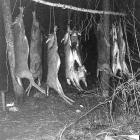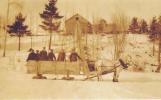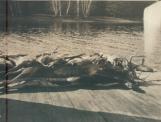1
During the 1800ís, 1900ís and to a lesser degree to the present time, trapping of a wide variety of animals in the Madawaska Valley area has been quite common by local farmers, professional trappers and Indians. The animals include mainly beaver, fox, wolf, coyote and muskrat. The trappers would skin the animals and tan the skins. There were many tanneries in towns and hamlets throughout the Valley at one time including one in Rockingham. The fur skins from these animals were tanned and sold throughout North America but the biggest market was in European countries for fur coats, hats and stoles. It has been said that at one time there were from 50 to 100 muskrat fur farmers in Ontario. Muskrats were sold from sixty to one hundred dollars. In those days that was a lot of money.3
Before the great depression on May 11, 1928, Mr. Sanford Melbourne Hacock and Robert Bruce Scott, both of Toronto, started an unusual business based on the marsh of the York River in the Township of Carlow in the County of Hastings: a muskrat farm known as the National Fur Farms Limited. These two businessmen assigned the company to their wives - Mary Elora Hacock and Mary G. Scott both of Toronto. This was probably done to limit any liabilities for the gentlemen. Mr. Hacock was born in Leeds County but came to Toronto from Saskatchewan. While in Toronto, in 1924, he operated a company called Canadian Silver Fox Company.The muskrat farm was located on a hill close to where the Conroy farm used to be at the Conroy rapids. The business bought lot numbers 26, 27, 28, 29, 30 in the tenth concession from various Taylor, Lavoy and Stringer families. These lots were located on both shores of the York branch of the York River and were 66 feet (one chain) in width. The business had as many as sixty employees working at the farm. The farm proceeded to fence at least 30 acres of marsh with chicken wire to trap and breed the animals. The farm would raise muskrats as stock for other fur farmers. The employees built log beds on the edge of the marsh, with holes up in them with wire mesh. The bait used was apples and carrots.
8
New Carlow resident Gordon Mayhew remembers working on the muskrat farm for five years until the operation went bankrupt in 1933. The two owners were absentee owners and spent most of their time in Toronto and perhaps this was a contributing factor in the companyís bankruptcy. A lack of money was also a reason that prevented success. When the company partnership was dissolved, the taxes were not paid and the original landowners got their land back for tax deeds. There was also a scandal of disappearing pelts at the end of the business, but the dwindling work crew finally did get paid.The muskrats that were raised in pens lost all idea of how to look after themselves and after the business closed they came out of holes, wandered everywhere, and were out of their orbit.
11
Bill and Henry Stringer tore the buildings down. Robert Graham took the tower down and used it as a sleep camp in his field and then left the property to his son Raymond.After the fiasco at Carlow, Sanford Hacock stayed in Toronto and owned/operated Mine Makers Ltd. from 1935 to 1948. Sanford was quite the entrepreneur as indicated above, but he also was a strong member of the Temperance Society in Ontario in 1821 and 1822. He worked for the police, nailing bootleggers for selling illegal alcohol. He died in February 1948 at the age of 69 years.







